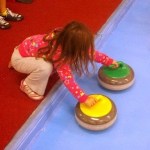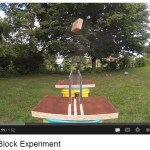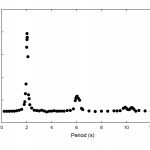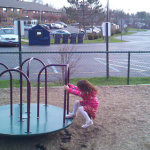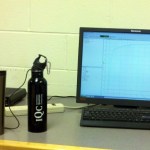Everyday
We spent this past weekend in Florida, visiting Kate's mom and her husband, who moved down there in October. This was a huge hit with the kids, who were very excited to fly on an airplane (four of them, actually, as we changed planes in Baltimore both ways). They also got a big kick out of driving around in a rental car-- The Pip chattered happily about "My new car" for a while-- which we did a lot of, going to a beach and the Mote Aquarium in Sarasota.
Doing all that driving in a rented SUV and a state with a 70mph speed limit got me thinking about optimum driving speed. Particularly on the…
I'm off to The City for TED@NYC on Tuesday, and while I might schedule something with the approximate text of my talk for Wednesday morning, more substantial blogging won't resume until Thursday. But I don't want to leave political post as the top thing on the blog, so here, have a cute kid picture.
This is SteelyKid at the Schenectady Curling Club, which had an open house this past weekend. Plan A was to go to the women's soccer game at Union instead, but I made the mistake of mentioning curling as a fallback in case of rain, and after half an hour of soccer, SteelyKid demanded "People…
After a couple of very productive days where I closed my Twitter tab because it was too freakin' annoying to read, I checked in briefly Wednesday morning, and found Rhett Allain and Frank Noschese discussing this Veritasium bullet-in-block experiment:
Tom at Swans On Tea offers some analysis, and Rhett offers a video response doing out some of the math:
I basically agree with their explanations, and that should have been that, except that in his discussion Rhett mentioned that the bullet probably doesn't go as far into the spinning block, which prompted Frank to ask whether you could…
SteelyPalooza came off very well, despite high disaster potential. We were, after all, inviting a dozen five-year-olds plus assorted siblings to our house, on a day when Kate and The Pip were out of commission due to coxsackie virus. Everything went smoothly, though: the kids loved the bouncy-bounce, SteelyKid's playset and playhouse, and the six-person tent we set up out back. They're getting close to an age where they can entertain themselves, so I was even able to enjoy snatches of adult conversation during brief lulls in my hosting duties.
This was, however, thoroughly exhausting, so…
Some time back, I spent a bunch of time writing a VPython program that simulated the motion of a pendulum, which turned out to do some strange things. In the comments to that, there were two things worth mentioning: first and foremost, Arnoques at #5 spotted a small error in the code that fixes the odd behavior noted in that post-- when I corrected it, the stretch needed to keep the pendulum swinging smoothly without oscillating in and out along the string was exactly what you would expect (the "factor" plotted in that earlier post is infinitesimally smaller than 1.0-- I got bored trying to…
The other day, I made a suggestion to one of my research students of an experiment to try. When I checked back a day later, she told me it hadn't worked, and I immediately realized that what I had told her to do was very stupid. As penance, then, I'll explain the underlying physics, which coincidentally has a nice summer-y sort of application alluded to in the post title.
If you're the sort of person who enjoys swimming, and can either open your eyes underwater or regularly wear a mask or goggles, you've probably notice that the underside of the surface of a swimming pool or other body of…
After Thursday's post about sports and statistics, a friend from my Williams days, Dave Ryan, raised an objection on Facebook:
There's an unstated assumption (I think) in your analysis: that there is some intrinsic and UNALTERABLE statistical probability of getting a hit inherent in every hitter. If that is the case, then yes -- a hitter whose mean is .274 that hits .330 in the first half should, reasonably, be expected to regress towards the "true" outcome of .274 in the second half; and if the hitter winds up batting .330, it's a statistical outlier. But that ONLY applies if the underlying…
Last week, I spent a bunch of time using VPython to simulate a simple pendulum, which was a fun way to fritter away several hours (yes, I'm a great big nerd), and led to some fun physics. I had a little more time to kill, so I did one of the things I mentioned as a possible follow-on, which turned out to be kind of baffling, in a good way.
Last week's post was written very quickly, and thus ended up a little more jargon-y than I usually shoot for, so let me try to set the stage a little better for this one. the physical system I'm talking about is just a simple pendulum, a mass on the end of…
There's a famous story about Richard Feynman at Cornell suffering from the science equivalent of writer's block, after WWII. He was depressed and feeling like everything he did was pointless, until one day he spotted a student throwing a plate up in the air in the cafeteria. As the plate spun, it wobbled, and the wobble seemed to go faster than the spin. Intrigued, he sat down and calculated the physics involved, finding that, indeed, the wobble should go at twice the rate of spin. This basically reignited his interest in physics, and shortly after that, began his legendarily productive…
The playground outside SteedlyKid's day care, amazingly in this litigious age, has a merry-go-round, a rotating disc with a really good bearing. The kids can really get the thing flying, which is kind of terrifying at times. But on the bright side, it's an excellent venue for the physics of angular momentum:
In the embedded video, SteelyKid runs in and starts the merry-go-round spinning, then jumps aboard and goes around one full rotation before moving to the center for a few rotations, and then starting to move back out.
This isn't exactly what I was hoping for-- amazingly, a four-and-two-…
It's been a while since I've done a post over-analyzing some everyday situation, because I've been too busy to do any silly experiments. We're on break this week, though, so I took a little time Monday to bring excessive technology to bear on the critically important scientific question: how good is my insulated Starbucks cup?
To back up a little bit, because it's always important to provide background and motivation when writing a lab report, I spend a lot of time working at Starbucks these days, because when I try to get work done in my office, people keep showing up wanting me to do stuff…
SteelyKid has started to demand Sid the Science Kid videos, which of course we are implacably opposed to around here. One of the recent episodes available online was "Slide to the Side," talking about friction. While this partakes a bit of the Feynman "Energy makes it go" problem, it was generally pretty good, and prompted a question from Kate that (combined with Rhett's latest.
Kate and SteelyKid were talking about how friction keeps things from sliding, then Kate asked me whether it would be possible to keep anything at rest on a truly frictionless surface, due to the rotation of the Earth…
While in the library looking for something else, I noticed a book called The Trouble with Science by Robin Dunbar, whose description made it sound very much on point for my current project:
In The Trouble with Science, Robin Dunbar asks whether science really is unique to Western culture, even to humankind. He suggests that our "trouble with science"--our inability to grasp how it works, our suspiciousness of its successes--may lie in the fact that evolution has left our minds better able to cope with day-to-day social interaction than with the complexities of the external world.
Somewhat…
Kate and I went down to New York City (sans kids, as my parents were good enough to take SteelyKid and The Pip for the weekend) this weekend, because Kate had a case to argue this morning, and I needed a getaway before the start of classes today. We hit the Rubin Museum of Art, which is just about the right size for the few hours we had, got some excellent Caribbean food at Negril Village, then saw The Old Man and the Old Moon in a church basement at NYU (the show was charming, the space was stiflingly hot by the end). All in all, a good weekend.
I drove back Sunday afternoon, and was…
Over at Tor.com, Kate has begun a chapter-by-chapter re-read of The Hobbit, and has some thoughts on Chapter 1. It's full of interesting commentary about characters and literary technique, but let's get right to the important bit: Physics!
Kate mentions in passing in the post that the Hobbit style round door with a knob in the middle seems a suboptimal design choice, however pretty it may look once Peter Jackson's set designers get done with it. This draws a couple of comments noting that the doorknob-in-the-middle thing is an English affectation, and pointing to the Prime Minister's…
In which we use math and physics to show that the pilots of my flight from Toronto to Albany this past weekend were full of crap.
------------
As previously noted, I was in Waterloo, Ontario this past weekend for the Open House at the University of Waterloo's new Quantum Nano Center. My talk went very well, save for some new-building technical glitches, and video of both the talk and the panel discussion should be posted to their web page soonish-- I'll post a link when it goes up.
The trip back from Toronto was slightly marred by the fact that the gates from which the tiny little prop planes…
Yesterday's post on applying intro physics concepts to the question of how fast and how long football players might accelerate generated a bunch of comments, several of them claiming that the model I used didn't match real data in the form of race clips and the like. One comment in particular linked to a PDF file including 10m "splits" for two Usain Bolt races, including a complicated model showing that he was still accelerating at 70m into the race. How does this affect my argument from yesterday?
Well, that document is really a guide to fancy fitting routines on some sort of graphing…
Over at Grantland, Bill Barnwell offers some unorthodox suggestions for replacing the kickoff in NFL games, which has apparently been floated as a way to improve player safety. Appropriately enough, the suggestion apparently came from Giants owner John Mara, which makes perfect sense giving that the Giants haven't had a decent kick returner since Dave Meggett twenty years ago, and their kick coverage team has lost them multiple games by giving up touchdowns to the other team.
Anyway, one of Barnwell's suggestions invoked physics, in a way that struck me as puzzling:
Idea 3: The receiving team…
So, the previous post poses a physics question based on some previous fooling around with modeling my commute:
A car starts from rest at the beginning of a straight 1km course, accelerates up to some speed, cruises at constant speed for a while, then decelerates to a stop at the end of the course. A second, identical car does the same course, but decelerates to a stop at the halfway point. It then immediately accelerates back to its cruising speed, and then decelerates to a stop at the end of the course.
How much faster does the second car have to go in order to complete the course in the…
Back in the summer, I did a post mathematically comparing two routes to campus, one with a small number of traffic lights, the other with a larger number of stop signs, and looked at which would be faster. Later on, I did the experiment, too.) Having spent a bunch of time on this, I was thinking about whether I could use this as a problem for the intro physics class. I decided against it last fall, but something else reminded me of this, and I started poking at it again.
So, I played around a bit with some numbers, and came up with the following possible framing for a question. I'll throw…

